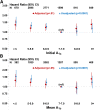Diabetic kidney disease: a report from an ADA Consensus Conference
- PMID: 25249672
- PMCID: PMC4170131
- DOI: 10.2337/dc14-1296
Diabetic kidney disease: a report from an ADA Consensus Conference
Abstract
The incidence and prevalence of diabetes mellitus have grown significantly throughout the world, due primarily to the increase in type 2 diabetes. This overall increase in the number of people with diabetes has had a major impact on development of diabetic kidney disease (DKD), one of the most frequent complications of both types of diabetes. DKD is the leading cause of end-stage renal disease (ESRD), accounting for approximately 50% of cases in the developed world. Although incidence rates for ESRD attributable to DKD have recently stabilized, these rates continue to rise in high-risk groups such as middle-aged African Americans, Native Americans, and Hispanics. The costs of care for people with DKD are extraordinarily high. In the Medicare population alone, DKD-related expenditures among this mostly older group were nearly $25 billion in 2011. Due to the high human and societal costs, the Consensus Conference on Chronic Kidney Disease and Diabetes was convened by the American Diabetes Association in collaboration with the American Society of Nephrology and the National Kidney Foundation to appraise issues regarding patient management, highlighting current practices and new directions. Major topic areas in DKD included 1) identification and monitoring, 2) cardiovascular disease and management of dyslipidemia, 3) hypertension and use of renin-angiotensin-aldosterone system blockade and mineralocorticoid receptor blockade, 4) glycemia measurement, hypoglycemia, and drug therapies, 5) nutrition and general care in advanced-stage chronic kidney disease, 6) children and adolescents, and 7) multidisciplinary approaches and medical home models for health care delivery. This current state summary and research recommendations are designed to guide advances in care and the generation of new knowledge that will meaningfully improve life for people with DKD.
© 2014 by the American Diabetes Association. Readers may use this article as long as the work is properly cited, the use is educational and not for profit, and the work is not altered.
Figures

References
-
- U.S. Renal Data System USRDS 2013 Annual Data Report: Atlas of Chronic Kidney Disease and End-Stage Renal Disease in the United States, National Institutes of Health, National Institute of Diabetes and Digestive and Kidney Diseases, Bethesda, MD, 2013: 1.7.2; 1.8.2.
-
- U.S. Renal Data System USRDS 2013 Annual Data Report: Atlas of Chronic Kidney Disease and End-Stage Renal Disease in the United States, National Institutes of Health, National Institute of Diabetes and Digestive and Kidney Diseases, Bethesda, MD, 2013:7.6.1; 7.9.1; 7.20.1.
-
- National Kidney Foundation KDOQI Clinical Practice Guidelines and Clinical Practice Recommendations for Diabetes and Chronic Kidney Disease. Am J Kidney Dis 2007;49(Suppl. 2)S12–S154 - PubMed
-
- Magee GM, Bilous RW, Cardwell CR, Hunter SJ, Kee F, Fogarty DG. Is hyperfiltration associated with the future risk of developing diabetic nephropathy? A meta-analysis. Diabetologia 2009;52:691–697 - PubMed
Publication types
MeSH terms
Substances
Grants and funding
LinkOut - more resources
Full Text Sources
Other Literature Sources
Medical
Research Materials

